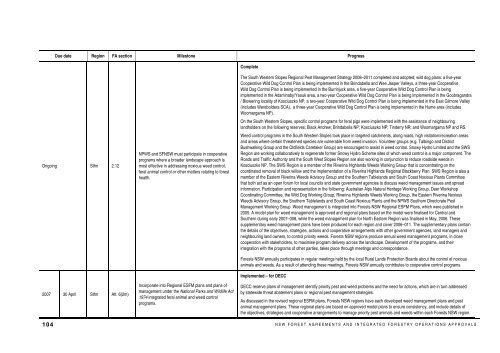Progress Report 2007-2008 - Department of Environment and ...
Progress Report 2007-2008 - Department of Environment and ...
Progress Report 2007-2008 - Department of Environment and ...
Create successful ePaper yourself
Turn your PDF publications into a flip-book with our unique Google optimized e-Paper software.
104<br />
Due date Region FA section Milestone <strong>Progress</strong><br />
Ongoing Sthn 2.12<br />
<strong>2007</strong> 30 April Sthn Att. 6(2m)<br />
NPWS <strong>and</strong> SFNSW must participate in cooperative<br />
programs where a broader l<strong>and</strong>scape approach is<br />
most effective in addressing noxious weed control,<br />
feral animal control or other matters relating to forest<br />
health.<br />
Incorporate into Regional ESFM plans <strong>and</strong> plans <strong>of</strong><br />
management under the National Parks <strong>and</strong> Wildlife Act<br />
1974 integrated feral animal <strong>and</strong> weed control<br />
programs.<br />
Complete<br />
The South Western Slopes Regional Pest Management Strategy <strong>2008</strong>–2011 completed <strong>and</strong> adopted; wild dog plans: a five-year<br />
Cooperative Wild Dog Control Plan is being implemented in the Brindabella <strong>and</strong> Wee Jasper Valleys, a three-year Cooperative<br />
Wild Dog Control Plan is being implemented in the Burrinjuck area, a five-year Cooperative Wild Dog Control Plan is being<br />
implemented in the Adaminaby/Yaouk area, a two-year Cooperative Wild Dog Control Plan is being implemented in the Goobrag<strong>and</strong>ra<br />
/ Blowering locality <strong>of</strong> Kosciuszko NP, a two-year Cooperative Wild Dog Control Plan is being implemented in the East Gilmore Valley<br />
(includes Wereboldera SCA), a three-year Cooperative Wild Dog Control Plan is being implemented in the Hume area (includes<br />
Woomargama NP).<br />
On the South Western Slopes, specific control programs for feral pigs were implemented with the assistance <strong>of</strong> neighbouring<br />
l<strong>and</strong>holders on the following reserves; Black Andrew; Brindabella NP; Kosciuszko NP; Tinderry NR; <strong>and</strong> Woomargama NP <strong>and</strong> RS.<br />
Weed control programs in the South Western Slopes took place in targeted catchments, along roads, high visitation/recreation areas<br />
<strong>and</strong> areas where certain threatened species are vulnerable from weed invasion. Volunteer groups (e.g. Talbingo <strong>and</strong> District<br />
Bushwalking Group <strong>and</strong> the Oldfields Caretaker Group) are encouraged to assist in weed control. Snowy Hydro Limited <strong>and</strong> the SWS<br />
Region are working collaboratively to regenerate former Snowy Hydro Scheme sites <strong>of</strong> which weed control is a major component. The<br />
Roads <strong>and</strong> Traffic Authority <strong>and</strong> the South West Slopes Region are also working in conjunction to reduce roadside weeds in<br />
Kosciuszko NP. The SWS Region is a member <strong>of</strong> the Riverina Highl<strong>and</strong>s Weeds Working Group that is concentrating on the<br />
coordinated removal <strong>of</strong> black willow <strong>and</strong> the implementation <strong>of</strong> a Riverina Highl<strong>and</strong>s Regional Blackberry Plan. SWS Region is also a<br />
member <strong>of</strong> the Eastern Riverina Weeds Advisory Group <strong>and</strong> the Southern Tablel<strong>and</strong>s <strong>and</strong> South Coast Noxious Plants Committee<br />
that both act as an open forum for local councils <strong>and</strong> state government agencies to discuss weed management issues <strong>and</strong> spread<br />
information. Participation <strong>and</strong> representation in the following: Australian Alps Natural Heritage Working Group, Deer Workshop<br />
Coordinating Committee, the Wild Dog Working Group, Riverina Highl<strong>and</strong>s Weeds Working Group, the Eastern Riverina Noxious<br />
Weeds Advisory Group, the Southern Tablel<strong>and</strong>s <strong>and</strong> South Coast Noxious Plants <strong>and</strong> the NPWS Southern Directorate Pest<br />
Management Working Group. Weed management is integrated into Forests NSW Regional ESFM Plans, which were published in<br />
2005. A model plan for weed management is approved <strong>and</strong> regional plans based on the model were finalised for Central <strong>and</strong><br />
Southern during early <strong>2007</strong>–008, while the weed management plan for North Eastern Region was finalised in May, 2006. These<br />
supplementary weed management plans have been produced for each region <strong>and</strong> cover 2006–011. The supplementary plans contain<br />
the details <strong>of</strong> the objectives, strategies, actions <strong>and</strong> cooperative arrangements with other government agencies, l<strong>and</strong> managers <strong>and</strong><br />
neighbouring l<strong>and</strong> owners, to control priority weeds. Forests NSW regions produce annual weed management programs, in close<br />
cooperation with stakeholders, to maximise program delivery across the l<strong>and</strong>scape. Development <strong>of</strong> the programs, <strong>and</strong> their<br />
integration with the programs <strong>of</strong> other parties, takes place through meetings <strong>and</strong> correspondence.<br />
Forests NSW annually participates in regular meetings held by the local Rural L<strong>and</strong>s Protection Boards about the control <strong>of</strong> noxious<br />
animals <strong>and</strong> weeds. As a result <strong>of</strong> attending these meetings, Forests NSW annually contributes to cooperative control programs<br />
Implemented – for DECC<br />
DECC reserve plans <strong>of</strong> management identify priority pest <strong>and</strong> weed problems <strong>and</strong> the need for actions, which are in turn addressed<br />
by statewide threat abatement plans or regional pest management strategies.<br />
As discussed in the revised regional ESFM plans, Forests NSW regions have each developed weed management plans <strong>and</strong> pest<br />
animal management plans. These regional plans are based on approved model plans to ensure consistency, <strong>and</strong> include details <strong>of</strong><br />
the objectives, strategies <strong>and</strong> cooperative arrangements to manage priority pest animals <strong>and</strong> weeds within each Forests NSW region.<br />
NSW FOREST AGREEMENTS AND INTEGRATED FORESTRY OPERATIONS APPROVALS

















